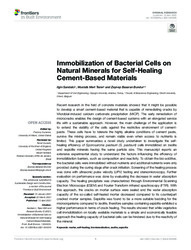Immobilization of bacterial cells on natural minerals for self-healing cement-based materials
| dc.contributor.author | Sandalcı, Ilgın | |
| dc.contributor.author | Tezer, M. M. | |
| dc.contributor.author | Bundur, Zeynep Başaran | |
| dc.date.accessioned | 2022-09-12T12:53:31Z | |
| dc.date.available | 2022-09-12T12:53:31Z | |
| dc.date.issued | 2021-04-13 | |
| dc.identifier.issn | 2297-3362 | en_US |
| dc.identifier.uri | http://hdl.handle.net/10679/7852 | |
| dc.identifier.uri | https://www.frontiersin.org/articles/10.3389/fbuil.2021.655935/full | |
| dc.description.abstract | Recent research in the field of concrete materials showed that it might be possible to develop a smart cement-based material that is capable of remediating cracks by Microbial-induced calcium carbonate precipitation (MICP). The early remediation of microcracks enables the design of cement-based systems with an elongated service life with a sustainable approach. However, the main challenge of the application is to extend the viability of the cells against the restrictive environment of cement-paste. These cells have to tolerate the highly alkaline conditions of cement paste, survive the mixing process, and remain viable even when access to nutrients is limited. This paper summarizes a novel study undertaken to investigate the self-healing efficiency of Sporosarcina pasteurii (S. pasteurii) cells immobilized on zeolite and sepiolite minerals having the same particle size. This manuscript reports an extensive experimental study to understand the factors influencing the efficiency of immobilization barriers, such as composition and reactivity. To obtain the bio-additive, the bacterial cells were immobilized without nutrients and additional nutrients were only provided during the curing stage after crack initiation. Screening of the healing process was done with ultrasonic pulse velocity (UPV) testing and stereomicroscopy. Further evaluation on performance was done by evaluating the decrease in water absorption capacity. The healing precipitate was characterized through Environmental Scanning Electron Microscope (ESEM) and Fourier-Transform infrared spectroscopy (FTIR). With this approach, the cracks on mortar surface were sealed and the water absorption capacity of the so-called self-healed mortar decreased compared to its counterpart cracked mortar samples. Sepiolite was found to be a more suitable bedding for the microorganisms compared to zeolite, therefore samples containing sepiolite exhibited a higher performance in terms of crack healing. The results showed that while vegetative cell immobilization on locally available materials is a simple and economically feasible approach the healing capacity of bacterial cells can be hindered due to the reactivity of the mineral. | en_US |
| dc.language.iso | eng | en_US |
| dc.publisher | Frontiers Media | en_US |
| dc.relation.ispartof | Frontiers in Built Environment | |
| dc.rights | openAccess | |
| dc.rights.uri | https://creativecommons.org/licenses/by/4.0/ | |
| dc.title | Immobilization of bacterial cells on natural minerals for self-healing cement-based materials | en_US |
| dc.type | Article | en_US |
| dc.description.version | Publisher version | |
| dc.peerreviewed | yes | en_US |
| dc.publicationstatus | Published | en_US |
| dc.contributor.department | Özyeğin University | |
| dc.contributor.authorID | (ORCID 0000-0003-1398-4021 & YÖK ID 205281) Başaran, Zeynep | |
| dc.contributor.ozuauthor | Bundur, Zeynep Başaran | |
| dc.identifier.volume | 7 | en_US |
| dc.identifier.wos | WOS:000644418000001 | |
| dc.identifier.doi | 10.3389/fbuil.2021.655935 | en_US |
| dc.subject.keywords | Biomineralization | en_US |
| dc.subject.keywords | Mortar | en_US |
| dc.subject.keywords | Self-healing | en_US |
| dc.subject.keywords | Sepiolite | en_US |
| dc.subject.keywords | Zeolite | en_US |
| dc.identifier.scopus | SCOPUS:2-s2.0-85104988762 | |
| dc.contributor.ozugradstudent | Sandalcı, Ilgın | |
| dc.relation.publicationcategory | Article - International Refereed Journal - Institutional Academic Staff and Graduate Student |
Files in this item
This item appears in the following Collection(s)
Share this page




